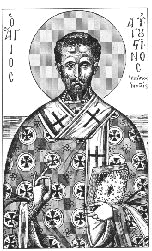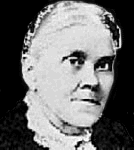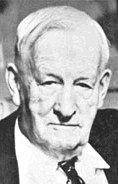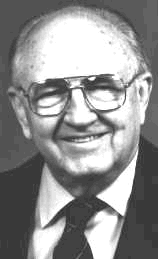
|
|
|||||
|
Southern Exposure |
|
Gavin Rumney |
Creationism? Good Grief! Part 2: A Prehistory of "Creation Science"
Read Part One
Gimme that old-time religion.
But is that old-time creationism really as old as some would like you to think it is?
And what role did self-styled prophetess Ellen G. White play in the evolution of creationism?

Augustine - not a creationist
Latter day creationists suffer under the illusion that their view of scripture is that of all Christians up till recent times. Then along came Charles Darwin to help sort out the sheep from the goats. The goats were subverted by the pseudo-science of evolution, and the sheep stayed loyal to God’s Word.
Well, not quite. Bob Bakker, who we met in part 1, draws our attention to Augustine, the church father who lived in the fifth century.
… after reading Genesis and thinking about it he came up with the conclusion that the story in Genesis 1 and Genesis 2 was not a simple historical sequence of events. It just couldn't be. It's not what the words meant. It just wasn't.
Bakker continues:
… you've got Jewish writers in the Middle Ages who wrote books on Genesis and they didn't read Augustine but they came away with the same conclusion: that the six days of Creation could not be six literal days. No way. That's not what the Hebrew says. And that they weren't six things in a row either but that they were six revelations of what happened in order of importance. So there are two thousand years of thoughtful guys reading The Old Testament carefully and treating it with respect and coming away with the conclusion that it was not simple, secular, history.
Perhaps it’s not surprising that these insights were largely confined to the well educated. After all, universal literacy is a very recent development. Most Christians at the time of Augustine, for example, could neither read nor write. We might even suspect that “holy mother church” preferred it that way. Ordinary lay people shouldn’t have to bother their silly little heads with complex matters. More trouble than it’s worth!
Something interesting happened, however, in the nineteenth century. There was an explosion of scholarship in Biblical studies. The power and influence of the churches to control that development was severely limited, for the universities were no longer under the thumb of bishops, and books were no longer the preserve of the few.
At the same time there was a new awareness of the obvious antiquity of the Earth. 6,000 years was not nearly enough time to account for the geology of the planet or the fossil record. And a vigorous and disturbing new theory had recently been introduced to account for the origin of species.
In America, however, there was especially stubborn resistance to the winds of change, despite the fact that many American academics had been (and are) in the forefront of both Biblical scholarship and the study of origins. It was here that “fundamentalism” was born in the early twentieth century. Between 1910 and 1915 a series of booklets was published called “The Fundamentals.” They attacked the new knowledge as evil and a sign of “liberalism.” In 1919 a convention was held in Philadelphia that attracted 6,000 people. A list of five fundamental beliefs was drawn up. One of those was the inerrancy of the Bible.
Inerrancy was seen as a bulwark against dangerous new theories about the Bible itself. And of course it also provided a rallying point against the idea of evolution. Yet even at this point the wackier fallacies we now associate with “creation science” were still in the future. According to Mark Noll, writing in the reviews section of First Things:
Despite a widespread impression to the contrary, "creationism" was not a traditional belief of nineteenth-century conservative Protestants or even of early-twentieth-century fundamentalists. During the century before the 1930s, most conservative Protestants believed that the "days" of Genesis, chapter one, stood for long ages of geological development or that a lengthy gap existed between the initial creation of the world (Gen. 1:1) and a series of more recent creative acts (Gen. 1:2ff.) during which the fossils were deposited. Some conservative Protestants early in the century - like James Orr of Scotland and B. B. Warfield of Princeton Theological Seminary, both of whom wrote for The Fundamentals (1910-15) - even allowed for large-scale evolution from one or only a few original life forms as a way of explaining God's way of creating plants, animals, and even the human body... Popular opponents of evolution in the 1920s like William Jennings Bryan had no difficulty accepting an ancient earth.


Ellen White
George McCready Price
So where did the kind of creationism we recognize today come from? It may come as a surprise to learn that one of the major influences was none other than Seventh-day Adventist prophetess Ellen G. White, something many Sunday-keeping fundamentalists might prefer not to know. Unable to carry the day in the arena of Biblical scholarship, and concerned that a non-literal reading of Genesis would undermine her rationale for Sabbath observance, she played the ultimate trump card by claiming a direct revelation from God. The Lord told his faithful handmaiden that the days of creation were indeed literal 24 hour days, and that the troublesome fossils used as evidence for an ancient Earth were merely proof of Noah’s flood. So there!
How did Mrs. White’s fantasies escape to infect the wider Christian community? Enter George McCready Price. This gentleman was a leading figure in Seventh-day Adventism, and creationism’s greatest champion till Henry Morris, a Southern Baptist, turned up in the early 1960s. The following biographical sketch comes from Dr. Ron Numbers, author of The Creationists: The Evolution of Scientific Creationism, and himself a former Adventist.
During the first two thirds of the twentieth century, during which most Christian fundamentalists accepted the existence of long geological ages, the leading voice arguing for the recent creation of life on earth in six literal days was George McCready Price (1870-1963), a scientifically self-taught creationist and teacher. Born and reared in the Maritime Provinces of Canada, Price as a youth joined the Seventh-day Adventists, a small religious group founded and still led [at that time] by a prophetess named Ellen G. White, whom Adventists regarded as being divinely inspired. Following one of her trance-like "visions" White claimed actually to have witnessed the Creation, which occurred in a literal week. She also taught that Noah’s flood had sculpted the surface of the earth, burying the plants and animals found in the fossil record, and that the Christian Sabbath should be celebrated on Saturday rather than Sunday, as a memorial of a six-day creation.
Shortly after the turn of the century Price dedicated his life to a scientific defense of White’s version of earth history: the creation of all life on earth no more than about 6,000 years ago and a global deluge over 2,000 years before the birth of Christ that had deposited most of the fossil-bearing rocks. Convinced that theories of organic evolution rested primarily on the notion of geological ages, Price aimed his strongest artillery at the geological foundation rather than at the biological superstructure. For a decade and a half Price’s writings circulated mainly among his coreligionists, but by the late 1910s he was increasingly reaching non-Adventist audiences. In 1926, at the height of the antievolution crusade, the journal Science described Price as "the principal scientific authority of the Fundamentalists." That he was, but with a twist. Although virtually all of the leading antievolutionists of the day, including William Jennings Bryan at the Scopes trial, lauded Price’s critique of evolution, none of them saw any biblical reason to abandon belief in the antiquity of life on earth for what Price called "flood geology." Not until the 1970s did Price’s views, rechristened "creation science," become fundamentalist orthodoxy.
Here's a further section from Mark Noll’s First Things article:
Modern creationism arose, by contrast, from the efforts of earnest Seventh-day Adventists who wanted to show that the sacred writings of Adventist-founder Ellen G. White (who made much of a recently created earth and the Noachian deluge) could provide a framework for studying the history of the earth. Especially important for this purpose was the Adventist theorist, George McCready Price (1870-1963), who published a string of creationist works, most notably The New Geology (1923). That book argued that a "simple" or "literal" reading of early Genesis showed that God had created the world six to eight thousand years ago and had used the Flood to construct the planet's geological past. Price, an armchair geologist with little formal training and almost no field experience, demonstrated how a person with such a belief could reconstruct natural history in order to question traditional understandings of the geological column and apparent indications that the earth was ancient. Price's ideas were never taken seriously by practicing geologists, and they had little impact outside of Adventist circles. One exception was the Lutheran Church-Missouri Synod, where a few energized critics of the modern world found Price's biblical literalism convincing, despite the fact that on almost every other religious question the Missouri Synod was about as far removed from Seventh-day Adventism as it was possible to be.
The Missouri Synod's publishing arm, Concordia Publishing House, began to disgorge creationist volumes (mainly written by the sect's ministers, who had even less expertise than Price.) These included Byron Nelson's Deluge Story in Stone and Alfred Rehwinkel's The Flood (I first read these books in the seventies when both were already well past their use-by dates - The Flood was written in the 1950s and Deluge Story even earlier. Incredibly both are still in print!) Prominent Synod member and rehabilitated Nazi scientist Wernher von Braun (who held rank in Hitler's SS) was even pressed into service to add credibility to the creationist stance.
Meanwhile George McCready Price wasn't limiting himself to creationist rhetoric. He was a dab hand at prophetic speculation as well, even authoring a book called The Time of the End. This tie-in between creationism and apocalyptic prediction isn’t uncommon, as anyone who has listened to Garner Ted Armstrong knows. Hard-line creationists tend to be obsessed with prophecy, and people who describe themselves as “students of prophecy” are invariably die-hard creationists. Some of Price’s anti-evolution propaganda is still available on the Internet.

Henry Morris
After Price's death the mantle was to fall to Henry Morris. Morris had the advantage of being closer to the Christian mainstream, unlike Price who many regarded as coming from a fringe group, so adding greater credibility to the cause among conservative Christians.
At last, in the late 1950s, a breakthrough occurred. John C. Whitcomb, Jr. (b. 1924), a theologian at Grace Theological Seminary (Winona Lake, Indiana) of the Grace Brethren denomination, and Henry M. Morris (b. 1918), a hydraulic engineer of Southern Baptist background, had each been moving in a creationist direction for quite a while before finding confirmation in Price's work. Each was also disturbed by a book published in 1954 by the evangelical Baptist theologian, Bernard Ramm, The Christian View of Science and Scripture... Soon after Whitcomb and Morris met each other they published The Genesis Flood (1961), an updating of Price's work, but one that, because of Whitcomb's theological contribution and Morris' scientific expertise, made Price's points more persuasively.
The rest is history - massive demand for The Genesis Flood (twenty-nine printings and sales in excess of 200,000 by the mid-1980s); the popularization (by Whitcomb, Morris, and others) of the creationist viewpoint in tens of millions of other books, articles, pamphlets, and Sunday School lessons; the entrance of creationism into Britain (where before conservative anti-evolutionists had almost never promoted the idea of a young earth); the translation of creationist materials into many foreign languages (including Turkish, for use in Islamic education)... (Noll)
While Morris was certainly more qualified than Price to speak on scientific matters, it shouldn’t perhaps be a surprise that his training was as a civil engineer. There has always been a do-it-yourself flavor to the creationist movement. Advocates like Morris, dedicated and sincere though they may be, are usually not writing in their field of expertise. While a number of “creation scientists” do posses valid credentials, they tend to be in areas like engineering, mathematics, physics and chemistry. The late Wernher Von Braun is a case in point.
These give them an inclination toward scientific explanations and a literal, face-value interpretation of respected writings… Disciplines which provide the historical dimension to creative processes are crucial to creationism. Respected geologists and astronomers who posses this needed perspective have not only avoided creationism, they are among its sharpest critics. (Elbert Dempsey, God’s Other Books. Herald House, 1987).
Copyright © 2003 Gavin Rumney
To be continued